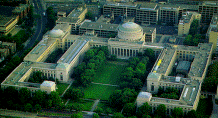 From MIT’s Mission and Origins
From MIT’s Mission and Origins
The Institute admitted its first students in 1865, four years after the approval of its founding charter. The event marked the culmination of an extended effort by William Barton Rogers, a distinguished natural scientist, to establish a new kind of independent educational institution relevant to an increasingly industrialized America. Rogers stressed the pragmatic and practicable. He believed that professional competence is best fostered by coupling teaching and research and by focusing attention on real-world problems. Toward this end, he pioneered the development of the teaching laboratory.
Today MIT is one of the world’s outstanding universities. Education and research—with relevance to the practical world as a guiding principle—continue to be its primary purpose. MIT is independent, coeducational, and privately endowed. It is organized into five schools that contain 27 academic departments as well as many interdepartmental programs, laboratories, and centers whose work extends beyond traditional departmental boundaries.
